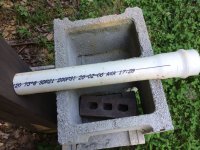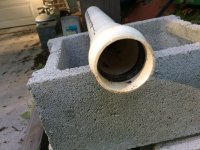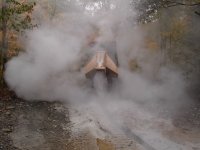I see the DWV marking, but also see the NSF which usually means ok for drinking water if I recall. We have black ABS for DWV here, but daughter in Maryland says all the DWV is white PVC there..
We had a leak at our first house, within a few feet of the meter in black poly. It was running a bunch of water and not any indication (buried 4+ feet deep, rocky soil that drained well). I heard water running at night when nothing was on. When I checked the meter with the main valve off at the house, the meter was spinning crazy fast. We turned the main valve off at the meter and it stopped then, so we knew for sure it was our side. Called the water company and asked for help. They promised someone would come right out, no one showed, 3 days later, I called a bit upset saying that I knew if was my responsibility but they keep promising someone would come out and help locate with their fancy equipment. Right after the 3rd day call, a manager came out in a suit. He took his jacket off, rolled up his sleeves, got a shovel out of the truck and said, let's find that leak. I asked about equipment and he said most times the leaks are close to the meter. We dug a deep by the meter and found the leak. Damaged section had a scuff mark running along the side, water guy said usually a sign of getting caught with backhoe, slight crease causes the inside to wear and over time develops a leak. They waived the water bill (it was 3600% increase over normal, but don't remember the $$).
Your leak looks like joint was not done properly (may be wrong glue, don't know). I am getting ready to make a device that uses 2" PVC and the video instructions stress doing it correctly or it will leak (even suggest marking depth it needs to be and especially making sure the sections are twisted at least 180 (half a rotation) as they are put together to avoid and air bubbles causing a straight line defect in glue joint that can leak over time). It would not surprise me if they did not twist the joint as they inserted and ended up with some defective joints. I suspect that perhaps the pressure was high when initially connected (stressing any weak joints) and then the pressure reducer was added. Perhaps after a couple initial leaks the pressure reducer was added.
If the whole situation does not go acceptably, then also consider notifying your federal representative.
Thanks for your families service.
adding to...
pending on glue (chemicals used), and by code. it is a good chance the glue needs to be of some color so as to quickly inspect to see joint has been at min primed. code may allow for clear solvent to be used after primer is applied. and/or using a combo primer/solvent all in one chemical.
de burr the ends (many times even new pipe. i have found i have scratched the end up some how. or it came that way with a "burr" little pieces of plastic sticking out off the end. the burrs will cause scraping and goouging of the fittings, which can cause leaks.
if you just insert a pipe directly into the fitting. it can leave "streaks", kinda like using a steak knife on a stick of butter, you see kinda of a drag marks on the butter were the knife sliced through. these can cause leaks.
by turning the pipe and/or fitting 180 degrees it is like smearing peanut butter on a piece of bread. as in you blob some peanut better and spread it out in a 1 direction, and then come at it 90 degrees at another direction to spread the peanut butter out. the turning 180 degrees is that spreading the solvent out. so any leak that might of had a chance to go directly between fitting and pipe is no longer there.
different types of solvents/primers. some are better for small size pipe example 1/2", 3/4", 1" while other solvent/primers, are better for larger pipe. the larger pipe stuff tends not to dry as quickly, but also more thick. (instead of water, more of a syrup or honey like doing. so as you are getting things together the solvent does not drip down and go some place else.
some solvents/primers are rated for only certain types of pipes and uses (abs, pvc, cpvc, etc...) most require to be used during certain temperatures, to cold or to warm. and there can be issues.
larger pipe generally requires "much more muscle" and 3" to 4" pipe it can get to point of needing a 2nd person. one holding fitting while other turns pipe.
to much can be a bad thing. i have had issues were i "gobbed" to much solvent and/or primer on. and the joint ended up being bad.
i have had plenty of pipe "slip back out" of a fitting. the need to hold for a min of 30 seconds. when initially putting the fittings together can be critical.
===========
pulling out old electrical, to water lines, to gas lines... having clean fill can be a major issue. once i start pulling out the old stuff. i required clean sand to be brought in. to compact below the pipe, around its sides and a couple inches above the pipe. you could clearly see places were rocks even river rock like places were stuff was about to split / crack / major damage soon enough about to happen.
============
other blah blah...
tv stations, most likely is not going to do OP much good.
state attorneys office, might help as a negotiator, but still may not resolve issues. it may take a few weeks before they even get to you, once you file a complaint with them.
BBB.org might help, might not. act same as state attorney office, but there would be a ticket made against company/s. BBB will stall ask what has been done to resolve issue.
get a third party plumber in there to get a couple bids. for repairing and replacing the line. so you have documentation. do not tell them the whole truth, tell them you getting bid to fix, and/or replace entire line. if it is more hassle for them, they will want to walk away. make it easy for third party.
small claims if the overall amount can fit in small claims court. if you win, you still have to collect fees. it can be a hassle, pay for the claim, pay for the summons, then you may or may not get delayed at court, filling in small claims make sure you type in "fees", with amount you ask. so it gets added in / dealt with if judge gives you that. if you win you still have to collect fees. if installer/plumber does not give you money. and there are rules of what you can and can not collect from. pending on state, small claims most likely will not cover any lawyer fees. regular court there might be a chance lawyer fees can be obtained with judgement.
insurance company both yours and installers/plumber, might be a good place to start. you need water, they might pay up quicker and less hassle.
the installer / main contractor should be required to keep all the documents of who they hired as sub contractors. pending on how house was built/bought, you may have had copies sent to you of who the sub contractors are as in documents.
============
what ever happens get it in writing. "word by mouth" will only go so far. and make sure you get something stating it will be done by X,y,Z date.
certified mail, and make yourself a copy of stuff sent to installer/plumber. scan it, take a picture of it, email it back to yourself. something to show, so if in front of judge, you have something say hey i went through this trouble of sending myself a copy, and showing certified mail that it was also obtained by whom ever and on given date.
if you have phone records. keep them. if you have text messages keep them. documentation. showing you have attempted to work issues out, and continuing issues still happen, and things are not getting resolved.




